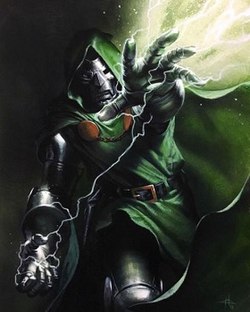 |
| via Marvel Database |
The most obvious reason for using a secret identity is to protect loved ones. If Dr. Octopus, for instance, were to learn of Spidey's alias, Aunt May would be in immediate peril, just as Lois Lane would be in the case of Superman (Spidey's parallel in the DC universe in many regards). Having a secret identity also allows a superhero to live a somewhat normal life on the side. With Spider-Man, especially, his "real world" contacts form an essential part of the story. His complicated relationship with Jonah Jameson wouldn't be nearly so interesting without his duality. Peter Parker's girlfriends become very important, not just to the Spidey saga but also - this is no exaggeration - to the broader history of American comic books.
One can also see some appeal to the target audience: let's face it, nerdy, school-age boys. You wouldn't be so mean to me, Mr. Bully, if you knew who I really am! Naturally, there's a parallel with a more recently invented hero: Harry Potter. His wizard identity isn't exactly a secret from the Dursleys but, once he learned of it, it gave him a great deal of leverage in his relationship with them that he didn't have before. It's satisfying to the reader - and probably the creator - in much the same way.
My Recent Reads
The Amazing Spider-Man #1
Originally published March 10, 1963
Writer: Stan Lee
Artist: Steve Ditko
- Introduction of Spidey's most important long-term nemesis: J. Jonah Jameson.
 |
| via Wikipedia |
- First crossover story, with the Fantastic Four.
- Introduction of a new villain: the Chameleon.
 |
| via Wikipedia |
The Amazing Spider-Man #2
Originally published May 10, 1963
Lee/Ditko
Originally published May 10, 1963
Lee/Ditko
- Two stories, two new villains: Vulture and Tinkerer
 |
| via Wikipedia |
 |
| via Marvel Database |
The Amazing Spider-Man #3
Originally published July 10, 1963
Lee/Ditko
Originally published July 10, 1963
Lee/Ditko
 |
| via Wikipedia |
- Doctor Octopus introduced.
- Human Torch (Fantastic 4) crossover.
The Amazing Spider-Man #4
Originally published September 10, 1963
Lee/Ditko
- The Sandman introduced.
 |
| via Wikipedia |
The Amazing Spider-Man #5
Originally Published October 10, 1963
Lee/Ditko
Originally Published October 10, 1963
Lee/Ditko
- Fantastic Four crossover
- Villain: Dr. Doom, more a Fantastic Four nemesis originally and historically, though he gets around to other series, too
 |
| via Wikipedia |
The Amazing Spider-Man #6
Originally Published November 10, 1963
Lee/Ditko
- The Lizard introduced.
 |
| via Wikipedia |
An interesting thing here: All of these characters are still around in Spider-Man and Marvel comics. Detective Comics took years to come up with this many characters that had any longevity to them.
ReplyDeleteI don't know DC as well. I wouldn't say I really know either well but I do know Marvel better. But in my opinion, the Joker has been DC's best character from the instant he was introduced. They didn't catch on to that until Jack Nicholson.
DeleteI read DC comics for the most part but I always had an issue believing Clark Kent could keep his secret identity given that he only wore glasses to disguise himself.
ReplyDeleteAt least Peter Parker wore a full face mask which I guess would also distort his voice. Now DC did some form of retconning on Superman back in the 90's saying Clark and Supes voices were different. Still couldn't believe his identity stayed secret.
Agreed. I always found it difficult to believe. It might help on screen if they'd cast dorkier actors as Clark Kent/Superman. I mean, c'mon: Christopher Reeve, Henry Cavill, Dean Cain? It's not as if these men are any less hunky with glasses on.
DeleteGuess what Squid, theres a real Spidey on youtube with 95,655,676 hits, cool huh? (https://www.youtube.com/watch?v=t-4lrt3twpU) I normally dont post links 'cos its spammy but in Spidermans case this is different.
ReplyDeleteHaha! I had a friend in college who would make surprise appearances around campus as Spider-Man.
DeleteThanks for sharing.